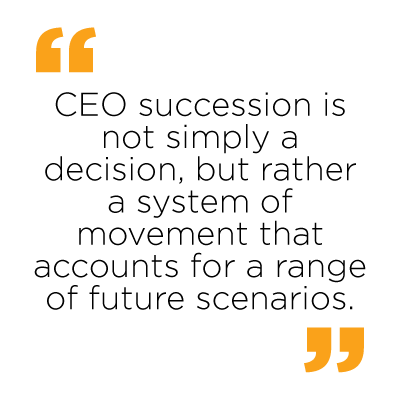(This article on CEO bench strength review is part three of our series on CEO succession planning conversations. See part one on identifying successors and part two on successor development invitations.)
If anything exposes a lack of bench strength, it’s when a board fills a CEO vacancy with a retired CEO instead of elevating a capable successor from within the organization.
Boomerang CEO stories—from Disney to Starbucks to Dell—have become more common in recent years, and I find myself fielding a lot of questions on this topic.
To be fair, scenarios like these typically involve factors beyond successor readiness including investor confidence issues, activist board members or stakeholders, and C-suite team dynamics that make it seem easier to reinstall a former chief executive than to introduce an unproven one.
But while shareholders may feel reassured by having a seasoned veteran back in the house, a worrisome skeleton hangs in the closet: No one inside the organization was ready to take the job.
A recent Bloomberg article dissecting Disney’s boomerang CEO Bob Iger succinctly described the challenge:
“From a succession standpoint, a boomerang is just a band-aid. […] Iger’s return reveals a more urgent question about what happens inside these boardrooms, where directors can see no other alternative to the future than what’s worked in the past. Yes, the prodigal son has returned. But really the board must do some deep soul searching as to why it so desperately needed him to come back.”
It turns out that what may feel like “safe bets” are actually quite unsafe. Boomerang CEOs often don’t deliver the hoped-for stability, on average delivering about 10% poorer stock performance during their second stints than first-time CEOs . Names like Starbuck’s Howard Shultz, Twitter’s Jack Dorsey, and Steve Ells from Chipotle are recent cases in point.
There’s a powerful myth to be dispelled here: In moments of great risk, boards are prone to consider past experience as the most reliable predictor of future success.
They’re only half right, and in the world of succession, that means wrong.

Past experience is indeed critical, but when the future is as complex and volatile as it is today, preparation is equal to experience in determining who is ready to lead an organization.
There is a long list of forces that can cause a new CEO to fail. But in far too many instances, the board has made poor predictions because they have not been having the right conversations about CEO succession all along.
As I’ve suggested in my earlier pieces, CEO succession is not simply a decision, but rather a system of movement that accounts for a range of future scenarios. The success of that system depends on the quality of the conversations happening around CEO successions.
In this piece, I’ll cover how the CEO and CHRO need to begin the conversation with the board about CEO bench strength.
When to present CEO candidates to the board
Boards, through one lens, are scrutiny machines. They exist to examine and render judgment about the appropriateness of the actions being taken by company leadership. And with CEO succession being one of the board’s principal accountabilities, that topic revs the scrutiny engine up to full horsepower.
So, it comes as no surprise that CEOs and CHROs exercise considerable caution before declaring one or more senior executives as potential CEO successors. As soon as the names are mentioned, the scrutiny begins.
Ideally, the CEO and CHRO should look to present candidates to the board only after they have:
- Created a success profile for a new CEO.
- Identified a slate of potential successors.
- Compiled performance, observational, and assessment data on the successors.
- Had conversations with potential successors to align their goals and motivations with opportunities.
In many cases the board (or subcommittee) may have involvement in the activities above, but getting into full conversations about readiness before these are complete can lead to misjudgments.
While timelines vary depending on the CEO’s plans and performance, initial conversations to review candidates (in some depth) generally happen six to nine months after the CEO and CHRO first begin identifying the successor pool (i.e., allowing for time to compile consistent, objective profiles and data for each successor).
CEO succession planning conversation #3: How is our CEO bench strength?
Having clarified the CEO success profile and begun the process of evaluating potential successors against it, it comes time to host a dialogue with the board about each individual.
In this crucial conversation, here are some of the key talking points, critical inputs, and commitments to consider:
Talking points:
- “What if” scenario planning: The success profile you create for your CEO should take into account the known forces affecting the future of your business, i.e., sector pivots, mergers or acquisitions, a digital transformation, divestitures, etc. Also at issue will be the unknowns or “what-ifs.” Is recession coming? Does our strategy remain intact, or will our new CEO need to usher in a new one? Are there competitive or market headwinds? How will the C-suite team be affected by each leader’s ascendance? While these questions seldom have answers, the failure to consider them can result in costly mistakes.
- Growth needs—easy vs. difficult: Because no leader is ever 100% ready for the CEO role, the question inevitably goes to the most critical development needs. More specifically, which areas of development will be easier or more difficult for each successor, and what are the associated risks? In a recent board dialogue about a brilliant CFO’s candidacy for the CEO role, a board member asked, “How will she respond to a totally unanticipated high-stress scenario?” While some personality data gave insight into how she handled high-pressure challenges, there was little proof of how she would handle truly unexpected dilemmas. And this, then, animated her development plan. If we don’t know, let’s find out. Recognizing that this was not a passing curiosity, but an important question about her potential, the CEO was able to seize real-time opportunities to put the CFO on point to address high-speed, high-visibility challenges and provide coaching as she navigated them. Her superior performance soon put questions to rest, and her development plan advanced.
Critical inputs:
- Objective, multi-method assessment data: Executive assessments can round out what you can’t see in performance data and 360-degree feedback. Perhaps more importantly, they can help you predict how executives will perform in C-level challenges that they haven’t yet had a chance to confront.
- Benchmarks (industry, global, functional): I have yet to encounter a board that is not keenly interested to know how their CEO candidates stack up, both within and outside their industry sector. Rightly so. Benchmarking not only helps to avoid over- or underestimating candidates, it also helps to separate a candidate’s unique skills from the existing company culture. For example, in a highly siloed organization, an executive may appear to be a strong networker, yet when compared to global benchmarks, their skill may fall significantly short.
- Self-awareness, growth orientation, coachability: These three qualities are critical components of successor profiles that should be discussed directly with the board, and may change over time as you observe CEO candidates stretching to meet new challenges. In many cases, this is where surprises emerge. An exceptional executive at the peak of their career in their current role may adopt a cautious orientation to new learning and growth while less experienced candidates may emerge as agile learners who show surprising strength when presented with unfamiliar challenges.
Key commitment: readiness = person + growth + context
As you progress through the initial CEO bench strength conversation with the board, it’s important to confront what it means for a candidate to be “ready.” As mentioned, no leader can ever be totally ready for a role as complex as CEO, so the more operative question is, “When is a candidate ‘ready enough’?”
Sadly there is no simple answer or definition that will serve the needs of thoughtful CEO succession decision making, but at the core, it’s critical to be thinking about three things:
- Success profile strength: Does this person currently show the skills, personal dispositions, and experience that meet the needs of our unique CEO success profile? How many, and how large are the gaps? What are the risks if the gaps aren’t closed, or closed in time?
- Growth orientation: Has this person shown that they are self-aware and receptive to feedback that will enable them to grow and face unexpected challenges? How have they demonstrated progress against their development objectives? Do we have clear evidence of growth (or just statements about it)? How likely is it that growth will continue after taking the role?
- Context fit: Given the changing context, does this leader’s profile align with current and emerging demands? Do their competencies and experience equip them to address the challenges we are likely to face? Are their natural dispositions and personality tendencies well-suited to the culture we are trying to promote?
The board review should trigger involvement and transparency
The chairman of a board with a three-decade track record of rigorous process and four highly successful CEO successions once said something that I’ve never forgotten. He compared the board’s role in CEO succession to watching runners at a track meet. “We’re not here to take snapshots as the athletes run past. It’s our job to get out on the track and run alongside them.” That’s a level of involvement and ownership of the development of successors that not all boards adopt.
Following board review conversations, the depth of understanding of potential successors often exceeds expectations. It’s not uncommon for board directors to feel a sudden and strong sense of clarity and progress, which may spill over into a perception that all is well in hand, and that little board action is needed until the moment of CEO succession arrives.
Nothing could be further from the truth. It’s at this point that the board’s attention and expectations should be aimed at ongoing updates and progress reports on the growth and development of all successors. As I mentioned earlier, boards often value experience over preparation, and it’s at this moment that both can be factored into the sustained succession conversation. That’s what the board chair above meant by “getting out on the track and run alongside them."
Another important but less obvious reason for the board’s sustained involvement is the mere fact that most of the people involved have never done this before. Twenty percent of public companies and 32% of private ones have yet to have their first conversation about CEO succession. And very few CEOs have experience developing a successor. The CHRO may be shepherding this process for the first time, or at best, may have done this once or twice before.
CEO Bench Strength Is a Continuous Conversation
The best chance organizations have at successful CEO succession is to establish the topic as a continuous, rigorous conversation about the growth and development of the organization’s most promising executives. In this article, we’ve discussed how to get that conversation going. In my last piece in this series, I’ll cover the ongoing conversations the board should have with the CEO, CHRO, and successors to ensure movement and growth over time.
View more of our series on four CEO succession conversations here:

Part one of our series on CEO succession planning conversations you MUST get right covers the conversation between the CEO and CHRO to identify potential successors.
BLOG
Part 1: Identifying Successors

Part two of our series on CEO succession planning conversations covers the conversation the CEO and CHRO have with executives to invite them to the successor development process.
BLOG
Part 2: Successor Development Invitations

The final part of our series on CEO succession planning conversations covers the conversation with the board as they evaluate CEO successor readiness.
BLOG
Part 4: CEO Successor Readiness
Get more executive insights by subscribing to our monthly Executive Outlook Newsletter.
Matt Paese, Ph.D., is Senior Vice President, Succession Management & C-Suite Services at DDI. He leads DDI’s Executive Services group, where he and his team help CEOs, boards, senior teams, and executives enhance leadership to grow business, cultural, and personal success.
Topics covered in this blog


